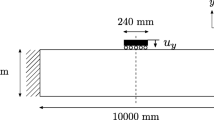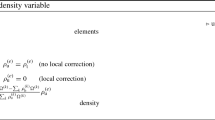Abstract
Stiffness topology optimization is usually based on a state problem of linear elasticity, and there seems to be little discussion on what is the limit for such a small rotation-displacement assumption. We show that even for gross rotations that are in all practical aspects small (<3 deg), topology optimization based on a large deformation theory might generate different design concepts compared to what is obtained when small displacement linear elasticity is used. Furthermore, in large rotations, the choice of stiffness objective (potential energy or compliance), can be crucial for the optimal design concept. The paper considers topology optimization of hyperelastic bodies subjected simultaneously to external forces and prescribed non-zero displacements. In that respect it generalizes a recent contribution of ours to large deformations, but we note that the objectives of potential energy and compliance are no longer equivalent in the non-linear case. We use seven different hyperelastic strain energy functions and find that the numerical performance of the Kirchhoff–St.Venant model is in general significantly worse than the performance of the other six models, which are all modifications of this classical law that are equivalent in the limit of infinitesimal strains, but do not contain the well-known collapse in compression. Numerical results are presented for two different problem settings.










Similar content being viewed by others
Notes
For the nested formulation, the last term disappears and the Lagrangian becomes the potential energy.
References
Bendsøe MP (1989) Optimal shape design as a material distribution problem. Struct Optim 1:193–202
Bendsøe M, Sigmund O (2002) Topology optimization, theory, methods and applications. Springer, New York
Bonet J, Wood RD (2008) Nonlinear continuum mechanics for finite element analysis. Cambridge University Press, Cambridge
Bruns TE, Sigmund O (2004) Toward the topology design of mechanisms that exhibit snap-through behavior. Comput Methods Appl Mech Eng 193:3973–4000
Bruns TE, Sigmund O, Tortorelli DA (2002) Numerical methods for the topology optimization of structures that exhibit snap-through. Int J Numer Methods Eng 55:1215–1237
Bruns TE, Tortorelli D (2001) Topology optimization of non-linear elastic structures and compliant mechanisms. Comput Methods Appl Mech Eng 190:3443–3459
Buhl T, Pedersen CB, Sigmund O (2000) Stiffness design of geometrically nonlinear structures using topology optimization. Struct Multidisc Optim 19:93–104
Cho S, Jung H-S (2003) Design sensitivity analysis and topology optimization of displacement-loaded non-linear structures. Comput Methods Appl Mech Eng 192:2539–2553
Christensen P, Klarbring A (2008) An introduction to structural optimization. Springer, New York
Curnier A (1994) Computational methods in solid mechanics. Kluwer Academic, Dordrecht
Fleury C (1979) Structural weight optimization by dual methods of convex programming. Int J Numer Methods Eng 14:1761–1783
Fleury C, Braibant V (1986) Structural optimization: a new dual method using mixed variables. Int J Numer Methods Eng 23:409–428
Gea HC, Luo J (2001) Topology optimization of structures with geometrical nonlinearities. Comput Struct 79:1977–1985
Groenwold AA, Etman LFP (2008) On the equivalence of optimality criterion and sequential approximate optimization methods in the classical topology layout problem. Int J Numer Methods Eng 73:297–316
Haftka RT, Gürdal Z (1992) Elements of structural optimization. Kluwer Academic, Dordrecht
Holzapfel GA (2000) Nonlinear solid mechanics, a continuum approach for engineering. Wiley, New York
Huang X, Xie YM (2008) Topology optimization of nonlinear structures under displacement loading. Eng Struct 30:2057–2068
Jung D, Gea HC (2004) Topology optimization of nonlinear structures. Finite Elem Anal Des 40:1417–1427
Kemmler R, Lipka A, Ramm E (2005) Large deformations and stability in topology optimization. Struct Multidisc Optim 30:459–476
Klarbring A, Strömberg N (2011) A note on the min-max formulation of stiffness optimization including non-zero prescribed displacements. Struct Multidisc Optim. doi:10.1007/s00158-011-0674-3
Lee WS, Youn SK (2004) Topology optimization of rubber isolators considering static and dynamic behaviours. Struct Multidisc Optim 27:284–294
Niu F, Xu S, Cheng G (2011) A general formulation of structural topology optimization for maximizing structural stiffness. Struct Multidisc Optim 43:561–572
Pajot JM, Maute K (2006) Analytical sensitivity analysis of geometrically nonlinear structures based on the co-rotational finite element method. Finite Elem Anal Des 42:900–913
Pedersen C, Buhl T, Sigmund O (2001) Topology synthesis of large-displacement compliant mechanisms. Int J Numer Methods Eng 50:2683–2705
Pedersen P, Pedersen N (2011) Design objectives with non-zero prescribed support displacements. Struct Multidisc Optim 43:205–214
Sigmund O (2001) A 99 line topology optimization code written in Matlab. Struct Multidisc Optim 21:120–127
Zhou M, Rozvany GIN (1991) The COC algorithm, part II: topological, geometrical and generalized shape optimization. Comput Methods Appl Mech Eng 89:309–336
Acknowledgement
This project was financed by Swedish Foundation for Strategic Research through the ProViking programme.
Author information
Authors and Affiliations
Corresponding author
Rights and permissions
About this article
Cite this article
Klarbring, A., Strömberg, N. Topology optimization of hyperelastic bodies including non-zero prescribed displacements. Struct Multidisc Optim 47, 37–48 (2013). https://doi.org/10.1007/s00158-012-0819-z
Received:
Revised:
Accepted:
Published:
Issue Date:
DOI: https://doi.org/10.1007/s00158-012-0819-z




